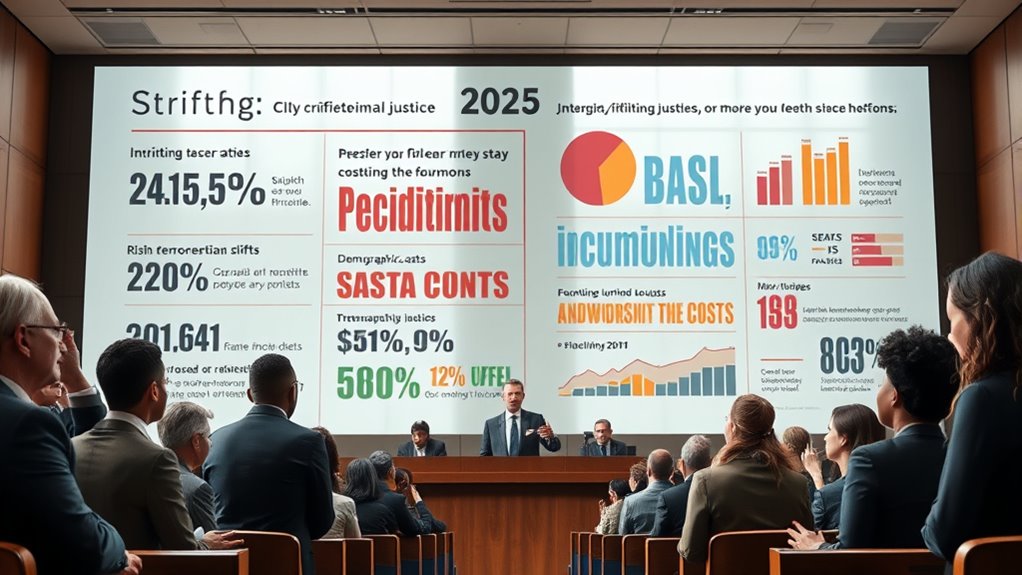In 2025, you’ll be surprised to learn nearly two-thirds of released inmates are rearrested within three years, highlighting the challenge of recidivism. Evidence-based programs focusing on vocational training, mental health, and community support are gaining traction, aiming to break this cycle. Many states are experimenting with holistic *transition* programs that include housing and employment help. If you’re curious about how these strategies are transforming justice, there’s much more to discover about these innovative reforms.
Key Takeaways
- Nearly 66% of released prisoners are rearrested within three years, highlighting persistent recidivism challenges.
- Evidence-based reforms, including vocational and mental health programs, are increasingly reducing reoffense rates across states.
- Transitional support initiatives combining housing and employment help stabilize reintegration, lowering prison populations.
- Community engagement and support networks significantly improve successful reintegration, emphasizing societal involvement in reform.
- Innovative, tailored rehabilitation programs and holistic approaches are driving transformative change in criminal justice policies.

Prison recidivism remains a major concern for the justice system. Nearly two-thirds of people released from prison are rearrested within three years, highlighting the need for better support systems and alternative programs. In 2025, you’ll see more states adopting evidence-based approaches, such as expanded vocational training, mental health services, and community-based supervision. These efforts aim to break the cycle of reoffending by addressing the root causes of criminal behavior. For example, some jurisdictions are experimenting with transitional programs that combine employment assistance with housing support, recognizing that stability reduces the likelihood of returning to crime. The focus on reducing recidivism isn’t just about lowering prison populations; it’s about giving individuals a real chance at rebuilding their lives, which benefits everyone. Additionally, as public awareness grows, there’s an increasing emphasis on inspirational quotes about fatherhood fostering community involvement and support networks that can aid in successful reintegration. Recognizing the importance of evidence-based approaches is crucial for developing effective policies that truly make a difference in reducing reoffending rates. Incorporating innovative rehabilitation programs can further enhance these efforts by providing tailored solutions that address individual needs. Furthermore, understanding the angel numbers associated with transformation and support can offer inspiring perspectives to both policymakers and individuals undergoing rehabilitation, emphasizing the significance of dynamic communication exercises for couples in building resilience and mutual understanding.
Frequently Asked Questions
How Will Reform Impact Recidivism Rates Nationwide?
Reform can lower recidivism rates nationwide by improving juvenile sentencing and parole policies. You’ll see fewer repeat offenses as programs focus on rehabilitation rather than punishment. With better parole systems, offenders get support to reintegrate into society, reducing the likelihood they’ll reoffend. Overall, these changes aim to create a more effective justice system where rehabilitation leads to lasting positive outcomes, benefiting communities and individuals alike.
What Are the Projected Costs of Implementing Reform Policies?
You’ll want to review the budget analysis and fiscal projections to understand the costs of implementing reform policies. These estimates can vary widely depending on reforms’ scope, but generally, initial investments include training, infrastructure, and technology upgrades. While upfront costs may seem high, many analysts believe these reforms will lead to long-term savings through reduced incarceration rates and improved community programs, ultimately balancing out initial expenditures over time.
How Will Reforms Affect Marginalized Communities’ Access to Justice?
Reforms aim to improve marginalized communities’ access to justice by addressing racial disparities and expanding community outreach. You’ll see increased support and resources in underserved areas, helping to reduce bias and discrimination. As policies focus on equitable treatment, you’ll notice more inclusive programs that empower these communities, ensuring fairer legal processes. Overall, reforms work toward closing justice gaps, making the system more accessible and just for everyone.
What Technology Innovations Are Expected to Support Reform Efforts?
You’ll see technology innovations like predictive analytics and digital monitoring play a vital role in reform efforts. Predictive analytics helps identify at-risk individuals early, enabling proactive support and reducing recidivism. Digital monitoring offers better supervision and accountability, making the justice system more transparent and fair. These tools empower you to support reforms that promote fairness, efficiency, and improved outcomes for marginalized communities, ensuring justice is accessible and equitable for all.
How Will Reforms Influence Police-Community Relations Long-Term?
Imagine a bridge being built between police and communities—reforms will strengthen those connections over time. By emphasizing community engagement and enhancing police training, you’ll see trust grow and misunderstandings decrease. These efforts help foster mutual respect, making interactions more positive. Long-term, you’ll notice safer neighborhoods and a more collaborative relationship, transforming the police into partners rather than distant authorities, creating a lasting impact that benefits everyone involved.
Conclusion
So, by 2025, you might find yourself marveling at how we’ve turned crime stats upside down—maybe even wondering if prisons will become luxury resorts or if judges will moonlight as stand-up comedians. Who knew reform could be so surprising? As you navigate this brave new world, remember: change is only shocking until it’s the new normal. Cheers to a future where justice is just a little more amusing and a lot more unpredictable!
Amina brings over a decade of journalism experience to her role as Editor-in-Chief. Under her leadership, Exquisite Post has flourished, maintaining the highest standards of integrity and excellence. Amina’s commitment to truth and her visionary approach guide the editorial team in producing impactful news stories that resonate with our audience.










